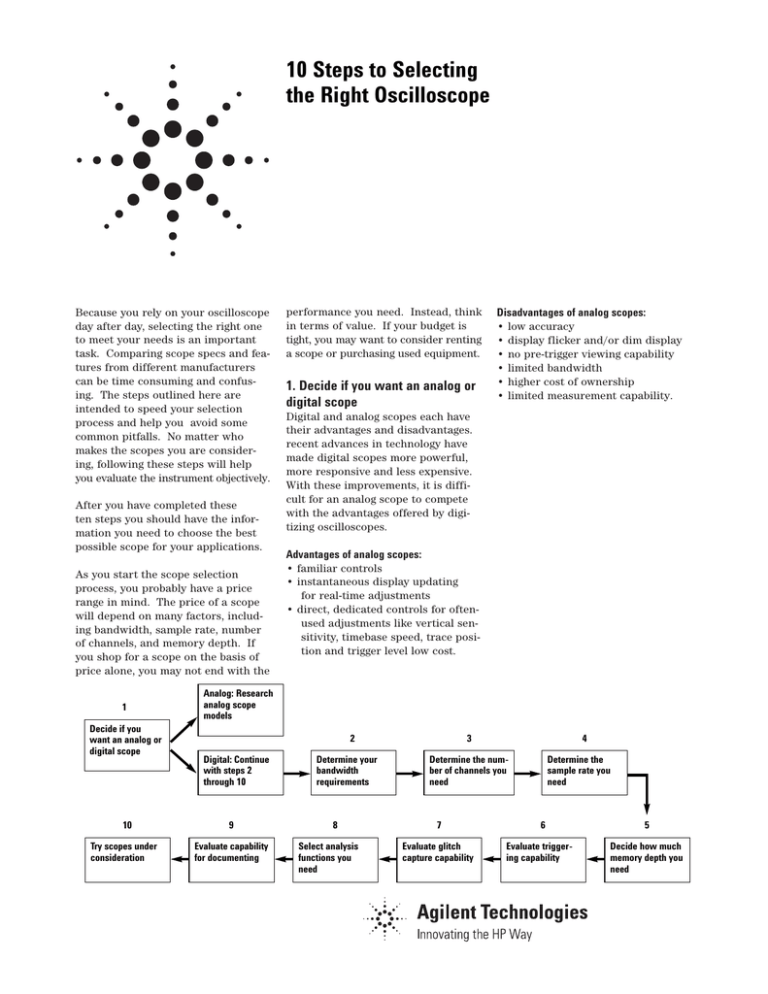Ten Steps to Selecting the Right Oscilloscope
advertisement

10 Steps to Selecting the Right Oscilloscope Because you rely on your oscilloscope day after day, selecting the right one to meet your needs is an important task. Comparing scope specs and features from different manufacturers can be time consuming and confusing. The steps outlined here are intended to speed your selection process and help you avoid some common pitfalls. No matter who makes the scopes you are considering, following these steps will help you evaluate the instrument objectively. After you have completed these ten steps you should have the information you need to choose the best possible scope for your applications. As you start the scope selection process, you probably have a price range in mind. The price of a scope will depend on many factors, including bandwidth, sample rate, number of channels, and memory depth. If you shop for a scope on the basis of price alone, you may not end with the 1 Decide if you want an analog or digital scope 10 Try scopes under consideration performance you need. Instead, think in terms of value. If your budget is tight, you may want to consider renting a scope or purchasing used equipment. 1. Decide if you want an analog or digital scope Disadvantages of analog scopes: • low accuracy • display flicker and/or dim display • no pre-trigger viewing capability • limited bandwidth • higher cost of ownership • limited measurement capability. Digital and analog scopes each have their advantages and disadvantages. recent advances in technology have made digital scopes more powerful, more responsive and less expensive. With these improvements, it is difficult for an analog scope to compete with the advantages offered by digitizing oscilloscopes. Advantages of analog scopes: • familiar controls • instantaneous display updating for real-time adjustments • direct, dedicated controls for oftenused adjustments like vertical sensitivity, timebase speed, trace position and trigger level low cost. Analog: Research analog scope models 2 Digital: Continue with steps 2 through 10 9 Evaluate capability for documenting Determine your bandwidth requirements 8 Select analysis functions you need 3 4 Determine the number of channels you need 7 Evaluate glitch capture capability Determine the sample rate you need 6 Evaluate triggering capability 5 Decide how much memory depth you need Advantages of digitizing scopes: • display storage • high-accuracy measurements • bright, well focused display at virtually any sweep speed • pre-trigger viewing capability • peak/glitch detection • automatic measurements • computer, printer/plotter connectivity • waveform processing capability including waveform math functions • display modes like averaging and infinite persistence • self calibration. Disadvantages of digitizing scopes: • can be more costly • can be less intuitive to operate (because they typically have more features). Weigh the advantages and disadvantages of analog and digitizing oscilloscopes for your particular applications. If you decide a digitizing scope provides you with the capabilities you need, proceed with steps two through ten. 2. Determine your bandwidth requirements Instruments that measure AC waveforms generally have some maximum frequency above which the measurement accuracy is degraded. This frequency is the bandwidth of the instrument and is usually defined as the frequency at which the instrument's response has decreased by 3 dB. The amount of bandwidth you need is determined by the characteristics of the signals that you will be observing and how accurately you wish to measure them. There are two kinds of scope bandwidth, repetitive (or analog) bandwidth and realtime bandwidth. Many digitizing scopes offer repetitive bandwidths that are higher than their basic sampling rates would seem to 2 allow. If a signal is repetitive, the scope doesn't have to sample it all at once. It can capture a piece of the waveform at each trigger occurrence and build up the display trace after many trigger cycles. (This process generally occurs so quickly that you will not notice it happening.) The repetitive bandwidth specification is therefore independent of the scope's sample rate. It is actually a measure of the bandwidth of the scope's analog amplifiers. Realtime bandwidth applies to nonrepetitive or single-shot signals, which the scope digitizes on one trigger. Realtime bandwidth is therefore dependent on the scope's sample rate. The ratio between sample rate and bandwidth varies. If the scope has digital reconstruction, the ratio can be as close as 4 to 1. Without reconstruction, the ratio is generally 10 to 1. See Step 4 for more information about sample rates. Many waveforms contains significant frequency components that are many times greater than the fundamental frequency of the waveform. For example, a square wave contains frequencies that are at least ten times the fundamental frequency of the signal. Higher bandwidth scopes will give you a more detailed picture of these high-frequency components. The screen shots in the following column show the same 50-MHz square wave displayed on four scopes with different bandwidths. The 500-MHz scope shows the most high-frequency detail and the best representation of signal rise times. The 150-MHz scope produces a display that has lost the high frequency details. The rise times displayed are slower than they are in reality. The 100-MHz scope has slowed the rise times even more. Also notice the amplitude attenuation. When the 50-MHz square wave on 20-MHz scope 50-MHz square wave on 100-MHz scope 50-MHz square wave on 150-MHz scope 50-MHz square wave on 500-MHz scope waveform is displayed by an oscilloscope and a bandwidth lower than the fundamental frequency of the square wave, the resulting display is very distorted. As a general rule of thumb, oscilloscope bandwidth should be at least three times the fundamental frequency of the fastest signal you expect to measure. Even higher bandwidth is required if you need higher accuracy. To make accurate amplitude measurements that are not dominated by the scope's frequency response, the scope's bandwidth should be ten times greater than the frequency of measured signals. For a typical instrument, the relationship between rise time and bandwidth is: The number of channels you need depends on your device under test. Two-channel scopes are the most popular. However, many engineers find 4-channel scopes useful for a variety of applications. Some points to consider: • Do you need to acquire multiple channels on the same triggering event? If so, select a scope with simultaneous acquisition or separate A/D converters on each channel. If your signals are repetitive, simultaneous acquisition is not required. .035 Tr= 3-dB bandwidth (in hertz) For timing measurements, the higher the ratio of signal rise time to scope rise time, the smaller the error. See the table below. Ratio of Signal Tr scope Tr 1:1 3:1 5:1 10:1 3. Determine the number of channels you need Calculated measurement to error 41.4% 5.4% 2.0% 0.5% In short, the more bandwidth you have (the faster the realtime), the more accurate your measurements will be. Some points to keep in mind: • Probing will also impact the accuracy of your measurements • Some scopes have bandwidth ratings that reflect their best performance only in certain voltage ranges, or only in 50Ω. • Bandwidth for analog scopes seldom exceeds 400 MHz, while some digitizing scopes have bandwidths up to 50 GHz. • Some scopes are 2+2, where 2 are full channels and 2 are auxiliary channels with limited attenuation range. In this case there are just two A/D converters shared between the four channels. Auxiliary channels give you some extra flexibility for looking at digital signals. • On 2-channel scopes, an external trigger can be helpful so that you don't have to use one of the viewable channels for a trigger. • If you are making digital timing measurements and you find yourself wanting more than four channels, consider a logic analyzer. Although you give up vertical resolution, you get high channel count and extra triggering and analysis capability. 4. Determine the sample rate you need The key performance specification for single-shot measurements is sample rate, the rate at which the scope can take a "snapshot" of the incoming signals. Higher sample rate translates into more realtime bandwidth and better real-time resolution. Most scope manufacturers use a sample rate to realtime bandwidth ratio of at least 4:1 (if digital reconstruction is employed) or 10:1 (without reconstruction) to prevent aliasing. Some scopes offer independent control of the sample rate, meaning you can adjust both the sample rate and the amount of data shown on screen (timebase) without one setting affecting the other. This feature allows you to maintain the desired resolution. Some points to keep in mind: • A scope's specified sample rate may only apply to single-channel acquisitions. Some scopes reduce the sample rate when multiple channels are activated. This can increase the possibility of aliased signals by changing the relationship of how fast the scope is sampling in relationship to the bandwidth of the signal. • Because of limited record length, most scopes only sample at the maximum rate on their fastest few sweep speeds. The sample rate is reduced at slow sweep speeds. • When capturing single-shot events, consider the importance of memory depth as well as sample rate. If you need to capture a pulse train without interruption, you'll need a scope with enough memory to capture the whole thing with good resolution. • Sample rate is not related to display up date speed. 5. Decide how much memory depth you need The memory depth you need depends on the overall time span you need to measure and the time resolution you require. If you're trying to capture a long time period with high resolution, you need more memory. 3 Deep memory lets you use a higher sample rate when you are at slow sweep speeds, so you have less chance of aliasing, and you get more detail on your waveforms. You can calculate the record depth you need with the following formula: Time span Record depth= Resolution needed A disadvantage of deep memory is that it can slow the scope's responsiveness since so much data must be processed. 6. Evaluate triggering capability Many general-purpose scope users get by using edge triggering. You may find it helpful in some applications to have additional triggering power. Advanced triggering allows you to isolate the events that you wish to view. In digital applications it is very helpful to trigger on a specific pattern across channels. In addition, state triggering allows you to sync up your pattern trigger to a clock edge. Glitch trigger allows you to trigger on a positive- or negative-going glitch or on a pulse greater than or less than a specified width. These features are especially powerful when troubleshooting. Trigger on the fault, and look backward in time (using the delay or horizontal position knob) to see what caused the problem. If more advanced logic triggering is needed, you may want to also consider a logic analyzer. TV trigger can trigger on the filed and specific line that you wish to view. On some scopes this is an optional feature. 4 7. Evaluate glitch capture capability Three important factors affect a scope's ability to capture glitches: Update rate: A digitizing scope must first acquire data, then process it and, finally, display it. The number of times a scope can perform this threestep process per second is the update rate. A scope with a fast update rate has a better chance of capturing infrequent glitches. Scopes with multi-processor architectures can have update rates many times faster than traditional single-processor scopes—making them better suited for capturing infrequent events. Multiprocessor architecture can produce display throughput and responsiveness that is similar to an analog scope's display. Peak detect capabilities: Most digitizing scopes reduce the effective sample rate at slow sweep speeds by simply throwing away sample points. This causes a problem, because narrow pulses or glitches that are easily viewable on fast timebase settings can disappear as the sweep speed is reduced. Look for a special acquisition mode called peak detect or glitch detect that maintains the maximum sample rate at all sweep speeds. The minimum and maximum values that occur during each sample period are recorded. The minimum glitch that can be detected is a function of the sample rate of the scope. Glitch triggering: Scopes with a glitch triggering feature let you isolate a hard-to-find glitch and trigger on it. This advanced function helps you find the cause of anomalies in circuit operation. See Step 6 for more on triggering. 8. Determine the analysis functions you need Automatic measurements and built-in analysis capability can save you time and make your job easier. Digitizing oscilloscopes frequently come with an array of measurement features and analysis options that are not available on analog scopes. Math functions include addition, subtraction, multiplication, division, integration and differentiation. Measurement statistics (min., max. and average) can qualify measurement uncertainty, a valuable asset when you're characterizing noise and timing margins. Some digitizing scopes offer FFT capability as well. Scopes with all if these advanced features may cost more, so you'll have to decide if they are worth the extra money. Let your application guide you in selecting scopes with these features. 9. Evaluate capability for documenting results Most digitizing scopes can be interfaced with a PC, a printer or plotter via GPIB, RS-232 or Centronics interfaces. Find out what interfaces are available and what printers are compatible. Keep in mind that printouts from laser and jet printers are much higher quality than thermal printouts. Look for a digitizing scope that comes with a floppy drive or software package that lets you easily transport waveform images and waveform data to a PC. These features will save you time and trouble when you want to include a screen capture in a report or transfer waveform data to a spreadsheet. 10. Try the scopes under consideration If you have thought through the previous nine steps, you have most likely narrowed the field to a limited number of scopes that meet your criteria. Now is the time to try them out and do a side-buy-side comparison. Borrow the scopes for a few days so you have time to evaluate them thoroughly. Some factors to consider as you use each scope: Ease of use: During your trial, evaluate each scope's ease of use. Are there easy-to-use dedicated knobs for often-used adjustments like vertical sensitivity, timebase speed, trace position and trigger level? How many buttons do you need to push to go from one operation to the next? Can you operate the scope intuitively while concentrating on your circuit under test? Display responsiveness: As you evaluate the scopes, pay attention to display responsiveness, a critical factor whether you're using your scope for trouble-shooting applications, or for gathering large quantities of data. When you change V/div, Time/div and position settings, does the scope respond quickly? Try the same thing with measurement features turned on. Is response noticeably slower? After you have thought about all these issues and evaluate the scopes have a good idea of which models will truly met your needs. If you're still unsure, you may want to discuss the choices with other scope users or call the manufacturer's technical support staff. Agilent Technologies’ Test and Measurement Support, Services, and Assistance Agilent Technologies aims to maximize the value you receive, while minimizing your risk and problems. We strive to ensure that you get the test and measurement capabilities you paid for and obtain the support you need. Our extensive support resources and services can help you choose the right Agilent products for your applications and apply them successfully. Every instrument and system we sell has a global warranty. Support is available for at least five years beyond the production life of the product. Two concepts underlie Agilent’s overall support policy: “Our Promise” and “Your Advantage.” Our Promise “Our Promise” means your Agilent test and measurement equipment will meet its advertised performance and functionality. When you are choosing new equipment, we will help you with product information, including realistic performance specifications and practical recommendations from experienced test engineers. When you use Agilent equipment, we can verify that it works properly, help with product operation, and provide basic measurement assistance for the use of specified capabilities, at no extra cost upon request. Many self-help tools are available. Your Advantage “Your Advantage” means that Agilent offers a wide range of additional expert test and measurement services, which you can purchase according to your unique technical and business needs. Solve problems efficiently and gain a competitive edge by contracting with us for calibration, extracost upgrades, out-of-warranty repairs, and on-site education and training, as well as design, system integration, project management, and other professional services. Experienced Agilent engineers and technicians worldwide can help you maximize your productivity, optimize the return on investment of your Agilent instruments and systems, and obtain dependable measurement accuracy for the life of those products. Get assistance with all your test and measurement needs at: www.agilent.com/find/assist Or check your local phone book for the Agilent office near you. Product specifications and descriptions in this document subject to change without notice. Copyright © 1998, 2000 Agilent Technologies Printed in U.S.A. 5/00 5968-2322E




